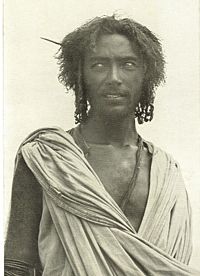Afar people
| Afar عفار |
|---|
 |
| Afar man in traditional nomad attire. |
| Total population |
|
over 1,500,000 |
| Regions with significant populations |
| Djibouti, Eritrea, Ethiopia, |
| Languages |
| Afar |
| Religion |
| Sunni Islam |
| Related ethnic groups |
| Agaw, Beja, Oromo, Saho, Somalis |
Afar (Afar alphabet Qafár, Feera ዐፋር ʿāfār, Arabic: عفار, Amh. translit. āfār, also spelled አፋር) are an ethnic group in the Horn of Africa who reside principally in the Danakil Desert in the Afar Region of Ethiopia, as well as in Eritrea and Djibouti. They are sometimes called Danakil, a name used specifically to refer to northern Afars, while southern Afars can be called Adel (also transliterated as Adal), similar to the former Adal Sultanate.
|
General
The Afar make up over a third of the population of Djibouti, and are one of the nine recognized ethnic divisions (kililoch) of Ethiopia. The Afar language, which is part of the Cushitic branch of the Afro-Asiatic language family, is spoken by ethnic Afars in the Afar Region of Ethiopia, as well as eastern Eritrea and Djibouti. However, since the Afar are traditionally nomadic herders, they may be found further afield.
Lifestyle and culture
Although some Afar have migrated to cities and adopted an urban lifestyle, the majority have remained nomadic pastoralists, raising goats, sheep, and cattle in the desert. During the dry season, most move to and camp on the banks of the Awash River. Camels comprise the most common means of transportation as the Afar nomads move from watering hole to watering hole. With the arrival of the rainy season in November, most relocate to higher ground in order to avoid flooding and mosquitos.
An Afar tent house is known as an ari and is made of sticks covered with mats; beds of mats raised on sticks are used. The burra or camp consists of two or more ari, and is the responsibility of the women. The Afar supplement their diet of milk and meat by selling salt that they dig from the desert along with milk and animal hides at markets in Senbete and Bati.
Traditionally, the society is ruled by sultanates made up of several villages headed by a dardar.
Afar are organized into clan families, and into classes -- asaimara ('reds') who are the dominant class politically, and the adoimara ('whites') who are a working class.
Circumcision is practiced for both boys and girls. A boy is judged for his bravery upon bearing the pain of circumcision, and is then allowed to marry the girl of his choice, though preferably someone from his own ethnic group.
The Afar have a strong relationship with their environment and its wildlife, sharing land and resources with animals and doing them no harm. It is this tendency that is largely responsible for the preservation of the critically endangered African wild ass (Equus africanus), which has become extinct in more vulnerable environments.
The Afar culture features unique items of clothing.
These include:
- When married, women traditionally wear a black headscarf called a shash or mushal.
- For men and women, the main article of clothing is the sanafil, a waistcloth. Women's are dyed brown (although today many women adopt multi-coloured sanafil) while men's are undyed.
Religion
The Afar began to convert to Islam in the 10th century after contact with Arab merchants from the Arabian Peninsula.
History
The earliest surviving written mention of the Afar was in the 13th century by the Arab writer ibn Sa'id, who reported that they lived in the area from around the port of Suakin as far south as Mandeb, near Zeila.[1] They are mentioned intermitently in Ethiopian records, first as helping Emperor Amda Seyon in a campaign beyond the Awash River, then over a century later when they assisted Emperor Baeda Maryam when he campaigned against their neighbors the Dobea.[2] In the late 17th century, the Aussa Sultanate had emerged, which became the first amongst equals of the Afar rulers.
In 1975 the Afar Liberation Front (ALF) began in Ethiopia after an unsuccessful rebellion led by a former Afar sultan. The Derg established the Autonomous Region of Assab (now called Aseb and located in Eritrea), although low level insurrection continued until the early 1990s. In Djibouti, a similar movement simmered throughout the 1980s, eventually culminating in the Afar Insurgency in 1991.
See also
- Afar Depression
- Kwosso